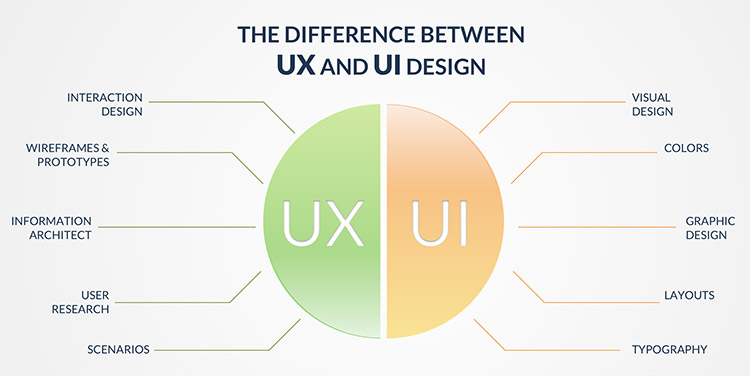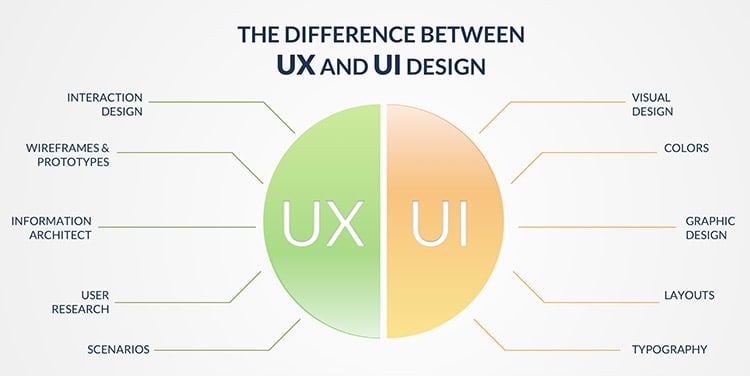What is UX Design? Definitions, examples from top industries and role
Today, many factors are involved when interacting with a customer via a website.

UI and UX design are two of the most often confused and conflated terms in web and app design.
UX - which stands for User Experience - and UI - which stands for User Interface - are two interdependent terms.
While UI generally deals with the interaction between users and computer systems, software and applications, UX deals more generally with a user’s overall experience with a brand, product or service.
In this article, we will try to get a better understanding of what UX and UI are, as well as the similarities and differences between both.
Are you interested in UX/UI Design? Let us help you and show you how you can implement UX/UI Design in your projects!
User experience is all about the user’s feelings and approaches towards using a specific product. User experience (UX) design is a process of designing products that offer relevant and valid experiences to users.
UX design includes designing the whole process of obtaining and incorporating the product consisting of usability, function, design and branding characteristics.
In other words, UX is the value that the user gets while using the product.
User Experience design considers every component that shapes the experience, the feeling it gives to the user, and how easy the user finds it to complete the desired tasks.
This could be anything from how the product feels in the user’s hand to how easy the checkout process is.
The main objective of UX design is to craft an effective, applicable, simple and wholesome pleasant experience for users.
To put it simply, UX is important because it tries to fulfill the user’s needs. It aims to provide positive experiences that keep users loyal to the product or brand.
Additionally, a meaningful user experience allows you to define customer journeys on your website that are most conducive to business success.
Imagine the following example: when accessing your website, a potential customer wants to know how to contact one of your salespeople.
He searches for a long time to find a link for the contact page, but the form is broken and it takes him three attempts to complete the request for a quote.
Now, what kind of experience do you think this user had?
During the search, he's probably already frustrated, don't you think?
Probably when faced with a problem on the form, it may be that you have become angry or discouraged.
The truth is that in such a situation, most users wouldn't even bother trying to log in three times, as in our example.
But the point is: who does, will not have the same willingness to continue the chat after receiving the contact from the seller, right?
In other words, a good user experience can help generate more leads and close more deals. On the other hand, a bad experience implies the opposite.
“UI” stands for “User interface”. It’s the process designers use to build interfaces in software or computerized devices, focusing on looks or style.
Designers aim to create interfaces which users find easy to use and pleasurable. UI design refers to graphical user interfaces and other forms.
The user interface is the graphical layout of an application. It consists of the buttons users click on, the text they read, the images, sliders, text entry fields, and all the rest of the items the user interacts with.
This includes screen layout, transitions, interface animations and every single micro-interaction. Any sort of visual element, interaction, or animation must all be designed.
This job falls to UI designers. They decide what the application is going to look like.
They have to choose color schemes and button shapes — the width of lines and the fonts used for text. UI designers create the look and feel of an application’s user interface.
UI designers are graphic designers. They’re concerned with aesthetics. It’s up to them to make sure the application’s interface is attractive, visually-stimulating and themed appropriately to match the purpose and/or personality of the app.
And they need to make sure every single visual element feels united, both aesthetically, and in purpose.
If your website doesn't direct users in the right way through the interface, they will hardly take the right actions. With that, this sales channel will fail in the business objectives.
Now, have you ever visited confusing websites that did not clearly communicate the value proposition or that made it difficult to find the necessary information and what you were looking for? Well, then you've been in the presence of examples of a poorly crafted UI.
And a poorly made UI costs a lot, since the almost immediate reaction of visitors will be to return to the search engine and switch to another website that offers a better experience.
But wait ... a better experience? Isn't that the role of the UX? Keep that in your mind because now we will tell you that the UI directly affects the UX, since if the navigation of your site is bad, it is quite difficult to provide a good experience.
However, that does not mean that the two concepts are the same thing. To be clear, let's see below 3 clear differences between them.
When comparing UI vs. UX, both develop processes and systems with the user in mind.
One focuses on the overall experience, while the other focuses on the opportunities for interaction through visual and auditory mediums.
User interface is a part of user experience. In fact, a user experience designer may uncover insights in their user research that a UI designer might later use to design an interface.
UX, however, is much broader and deals with the start to finish experience of a product or system.
UX has a lot to do with brand building. A positive UX may outpace the competition and corner a market. Think about Amazon Prime.
The ease of next-day or two-day delivery has made this method of shopping highly attractive to consumers. Amazon’s UI design deals with the layout of the website, the search bar and clarity of information on product pages.
UI designers might think about making it clear if a product is eligible for two-day shipping through the use of icons, or build a bright button to encourage users to check out with one click.
UX designers, on the other hand, may ask questions like: Did the customer find the product they were looking for? Did it arrive when it was supposed to?
UX deals with the overall experience while UI deals with the specifics of how the user interacted with the site’s visual and technical components.
UI design is more concerned with the surface and overall feel of a design. UI design is a craft where you the designer build an essential part of the user experience.
UX design covers the entire spectrum of the user experience. One analogy is to picture UX design as a car with UI design as the driving console.

User Interface tends to do more with the actual features of the device, such as the screen, buttons, scrolling features and sound; user experience is the more general term that deals with everything a user experiences from start to finish.
UI is a key part of a user’s overall experience since it’s the part of a device that a user most interacts with, but it doesn’t cover the entirety of a user’s experience across a website or platform.
Another common metaphor for UI vs. UX is to compare them to restaurants. If UI is the plate, silverware and napkins, UX is the lighting, music and customer service that facilitates your dining experience.
While UX and UI are interrelated, a few key differences exist. First, UI deals specifically with digital devices and people’s ability to use them. User experience is a term that deals with interaction with a brand, product or service more broadly.
While it’s often used in the context of devices, user experience doesn’t have to be about digital products. Another difference between UI and UX: UX is more about how a product makes you feel, while UI is more about how it looks.
For instance, a website might look great but be really hard to use (great UI but terrible UX), or vice versa. In this way, UX and UI go hand-in-hand.
However, UI vs. UX designers may employ different skill sets and tend to work at different stages in the process.
To conclude, UX tends to come first as user experience designers start by researching users extensively to understand their goals and pain points.
They typically map the entire user journey and note ways to improve it. Sometimes, they create wireframes of their findings.
Then, a UI designer makes the UX recommendations come to life. Based on the user journey and wireframes, for example, they implement changes across a website.
At this stage, a UI designer takes the UX designer’s considerations into mind when developing designs that meet the needs of users.
There may also be a feedback loop that exists between user experience and user interface; UX designers might test an interface once a UI designer creates it.
You have already perceived that both UI and UX have great value for the success of your digital strategy. So it's natural for you to ask yourself: which of the two should I use?
However, the answer is: both. There is no reason to choose just one or to think that there is somehow competition between them. As we already talked about, UI and UX complement each other.
Separately, each one can bring good results for your company, but only if you use both together will you have the following benefits:
With both, a well-designed interface and deep knowledge about how your buyer persona behaves, it is possible to generate much more value for your audience than if you only had one of the elements in your strategy.
Remember that generating value for your audience is never too much. In the end, although not all visitors are ready to take immediate action, they are likely to come back if the UI and UX work is done well.
One of the main success metrics for many sites and applications is the length of time users have been on the website. This indicator is used when engagement is important for the success of the project.
If this is your situation, there is nothing more valuable than combining a good interface with a positive user experience.
This couple is responsible for the retention and enchantment of users, which generates traffic and more engagement that comes from recommendations.
Brands that care about the complete experience that customers have in their digital channels achieve the strengthening of the relationship with users.
In the digital world everything is shared, which involves the joys and frustrations of people with their favorite brands.
So, one way or another, people will comment on your brand. The quality of the UI and UX work is what determines whether that will be good or bad news for you.
At the end of it all, nothing is more important than conversions in a digital strategy.
That is why any company invests in Digital Marketing and striving for the design of the interfaces, as well as the complete experience, is what guarantees the return on this investment.
The best thing is that after seeing positive results, it is possible to continue optimizing efforts and reaching even higher goals on a regular basis.
Are you interested in UX/UI Design? Let us help you and show you how you can implement UX/UI Design in your projects!

Today, many factors are involved when interacting with a customer via a website.

User experience, today, stands as an indisputable pillar for most of the businesses on the road, to succeed in the era of customer focus.

We know that trends in the digital world change year by year. If we talk about web design and UX design, next year there will be great innovations in...